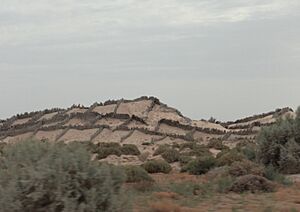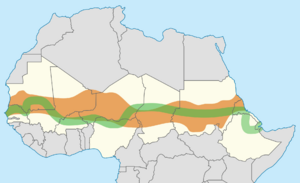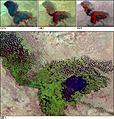Desertification facts for kids

Desertification is the expansion of desert into the surrounding areas. The desert area in the world is getting bigger.
Humans can fight desertification in various ways. For instance, improving soil quality, greening deserts, managing grazing better, and planting trees (reforestation and afforestation) can all help reverse desertification.
Contents
History
The world's most noted deserts have been formed by natural processes interacting over long intervals of time. During most of these times, deserts have grown and shrunk independently of human activities. Paleodeserts are large sand seas now inactive because they are stabilized by vegetation, some extending beyond the present margins of core deserts, such as the Sahara, the largest hot desert.
Historical evidence shows that the serious and extensive land deterioration occurring several centuries ago in arid regions had three centers: the Mediterranean, the Mesopotamian Valley, and the Loess Plateau of China, where population was dense.
The earliest known discussion of the topic arose soon after the French colonization of West Africa, when the Comité d'Etudes commissioned a study on desséchement progressif to explore the prehistoric expansion of the Sahara Desert. The modern study of desertification emerged from the study of the 1980s drought in the Sahel.
Causes
Desertification usually happens on the edge of deserts. A variety of factors causes it.
- Climatic change (natural factor)
- Rapid population growth (human factor)
- Overgrazing
- Deforestation
- Drought
- Incorrect Irrigation
Effects
Sand and dust storms
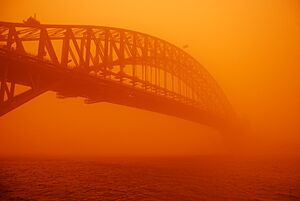
There has been a 25% increase in global annual dust emissions between the late nineteenth century to present day. The increase of desertification has also increased the amount of loose sand and dust that the wind can pick up ultimately resulting in a storm. For example, dust storms in the Middle East “are becoming more frequent and intense in recent years” because “long-term reductions in rainfall [cause] lower soil moisture and vegetative cover”.
Dust storms can contribute to certain respiratory disorders such as pneumonia, skin irritations, asthma and many more. They can pollute open water, reduce the effectiveness of clean energy efforts, and halt most forms of transportation.
Dust and sand storms can have a negative effect on the climate which can make desertification worse. Dust particles in the air scatter incoming radiation from the sun (Hassan, 2012). The dust can provide momentary coverage for the ground temperature but the atmospheric temperature will increase. This can disform and shorten the life time of clouds which can result in less rainfall.
Food insecurity
Global food security is being threatened by desertification. The more that population grows, the more food that has to be grown. The agricultural business is being displaced from one country to another. For example, Europe on average imports over 50% of its food. Meanwhile, 44% of agricultural land is located in dry lands and it supplies 60% of the world's food production. Desertification is decreasing the amount of sustainable land for agricultural uses but demands are continuously growing. In the near future, the demands will overcome the supply. The violent herder–farmer conflicts in Nigeria, Sudan, Mali and other countries in the Sahel region have been exacerbated by climate change, land degradation and population growth.
Increasing poverty

At least 90% of the inhabitants of drylands live in developing countries, where they also suffer from poor economic and social conditions. This situation is exacerbated by land degradation because of the reduction in productivity, the precariousness of living conditions and the difficulty of access to resources and opportunities.
Many underdeveloped countries are affected by overgrazing, land exhaustion and overdrafting of groundwater due to pressures to exploit marginal drylands for farming. Decision-makers are understandably averse to invest in arid zones with low potential. This absence of investment contributes to the marginalization of these zones. When unfavorable agri-climatic conditions are combined with an absence of infrastructure and access to markets, as well as poorly adapted production techniques and an underfed and undereducated population, most such zones are excluded from development.
Desertification often causes rural lands to become unable to support the same sized populations that previously lived there. This results in mass migrations out of rural areas and into urban areas particularly in Africa creating unemployment and slums. The number of these environmental refugees grows every year, with projections for sub-Saharan Africa showing a probable increase from 14 million in 2010 to nearly 200 million by 2050. This presents a future crisis for the region, as neighboring nations do not always have the ability to support large populations of refugees.
In Mongolia, the land is 90% fragile dry land, which causes many herders to migrate to the city for work. With very limited resources, the herders that stay on the dry land graze very carefully in order to preserve the land.
Agriculture is a main source of income for many desert communities. The increase in desertification in these regions has degraded the land to such an extent where people can no longer productively farm and make a profit. This has negatively impacted the economy and increased poverty rates.
There is, however, increased global advocacy e.g. the UN SDG 15 to combat desertification and restore affected lands.
Reversing desertification
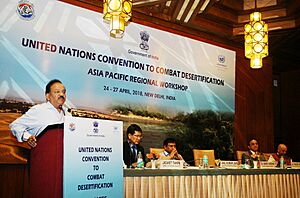
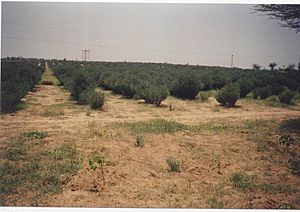
Techniques and countermeasures exist for mitigating or reversing desertification. For some of these measures, there are numerous barriers to their implementation. Yet for others, the solution simply requires the exercise of human reason.
One proposed barrier is that the costs of adopting sustainable agricultural practices sometimes exceed the benefits for individual farmers, even while they are socially and environmentally beneficial. Another issue is a lack of political will, and lack of funding to support land reclamation and anti-desertification programs.
Desertification is recognized as a major threat to biodiversity. Some countries have developed biodiversity action plans to counter its effects, particularly in relation to the protection of endangered flora and fauna.
Improving soil quality
Techniques focus on two aspects: provisioning of water, and fixation and hyper-fertilizing soil. Fixating the soil is often done through the use of shelter belts, woodlots and windbreaks. Windbreaks are made from trees and bushes and are used to reduce soil erosion and evapotranspiration. They were widely encouraged by development agencies from the middle of the 1980s in the Sahel area of Africa.
Some soils (for example, clay), due to lack of water can become consolidated rather than porous (as in the case of sandy soils). Some techniques as zaï or tillage are then used to still allow the planting of crops.
Another technique that is useful is contour trenching. This involves the digging of 150 m long, 1 m deep trenches in the soil. The trenches are made parallel to the height lines of the landscape, preventing the water from flowing within the trenches and causing erosion. Stone walls are placed around the trenches to prevent the trenches from closing up again. This method was invented by Peter Westerveld.
Enriching of the soil and restoration of its fertility is often achieved by plants. Of these, leguminous plants which extract nitrogen from the air and fix it in the soil, succulents (such as Opuntia), and food crops/trees as grains, barley, beans and dates are the most important. Sand fences can also be used to control drifting of soil and sand erosion.
Another way to restore soil fertility is through the use of nitrogen-rich fertilizer. Due to the higher cost of this fertilizer, many smallholder farmers are reluctant to use it, especially in areas where subsistence farming is common. Several nations, including India, Zambia, and Malawi have responded to this by implementing subsidies to help encourage adoption of this technique.
Some research centres (such as Bel-Air Research Center IRD/ISRA/UCAD) are also experimenting with the inoculation of tree species with mycorrhiza in arid zones. The mycorrhiza are basically fungi attaching themselves to the roots of the plants. They hereby create a symbiotic relation with the trees, increasing the surface area of the tree's roots greatly (allowing the tree to gather much more nutrient from the soil).
The bioengineering of soil microbes, particularly photosynthesizers, has also been suggested and theoretically modeled as a method to protect drylands. The aim would be to enhance the existing cooperative loops between soil microbes and vegetation.
Desert greening
As there are many different types of deserts, there are also different types of desert reclamation methodologies. An example for this is the salt flats in the Rub' al Khali desert in Saudi Arabia. These salt flats are one of the most promising desert areas for seawater agriculture and could be revitalized without the use of freshwater or much energy.
Farmer-managed natural regeneration (FMNR) is another technique that has produced successful results for desert reclamation. Since 1980, this method to reforest degraded landscape has been applied with some success in Niger. This simple and low-cost method has enabled farmers to regenerate some 30,000 square kilometers in Niger. The process involves enabling native sprouting tree growth through selective pruning of shrub shoots. The residue from pruned trees can be used to provide mulching for fields thus increasing soil water retention and reducing evaporation. Additionally, properly spaced and pruned trees can increase crop yields. The Humbo Assisted Regeneration Project which uses FMNR techniques in Ethiopia has received money from The World Bank's BioCarbon Fund, which supports projects that sequester or conserve carbon in forests or agricultural ecosystems.
Better managed grazing
Restored grasslands store CO2 from the atmosphere as organic plant material. Grazing livestock, usually not left to wander, consume the grass and minimize its growth. A method proposed to restore grasslands uses fences with many small paddocks, moving herds from one paddock to another after a day or two in order to mimic natural grazers and allowing the grass to grow optimally. Proponents of managed grazing methods estimate that increasing this method could increase carbon content of the soils in the world's 3.5 billion hectares of agricultural grassland and offset nearly 12 years of CO2 emissions.
Planting trees
Reforestation gets at one of the root causes of desertification and is not just a treatment of the symptoms. Environmental organizations work in places where deforestation and desertification are contributing to extreme poverty. There they focus primarily on educating the local population about the dangers of deforestation and sometimes employ them to grow seedlings, which they transfer to severely deforested areas during the rainy season. The Food and Agriculture Organization of the United Nations launched the FAO Drylands Restoration Initiative in 2012 to draw together knowledge and experience on dryland restoration. In 2015, FAO published global guidelines for the restoration of degraded forests and landscapes in drylands, in collaboration with the Turkish Ministry of Forestry and Water Affairs and the Turkish Cooperation and Coordination Agency.
The "Green Wall of China" is a high-profile example of one method that has been finding success in this battle with desertification. This wall is a much larger-scale version of what American farmers did in the 1930s to stop the great Midwest dust bowl. This plan was proposed in the late 1970s, and has become a major ecological engineering project that is not predicted to end until the year 2055. According to Chinese reports, there have been nearly 66 billion trees planted in China's great green wall. The green wall of China has decreased desert land in China by an annual average of 1,980 square km. The frequency of sandstorms nationwide have fallen 20% due to the green wall. Due to the success that China has been finding in stopping the spread of desertification, plans are currently being made in Africa to start a "wall" along the borders of the Sahara desert as well to be financed by the United Nations Global Environment Facility trust.
In 2007 the African Union started the Great Green Wall of Africa project in order to combat desertification in 20 countries. The wall is 8,000 km wide, stretching across the entire width of the continent and has 8 billion dollars in support of the project. The project has restored 36 million hectares of land, and by 2030 the initiative plans to restore a total of 100 million hectares. The Great Green Wall has created many job opportunities for the participating countries, with over 20,000 jobs created in Nigeria alone.
Interesting facts about desertification
- The United Nations predicts that within the next 10 years, 50 million people in the drylands will be displaced due to desertification.
- Approximately 2 billion people rely on and live in dryland area climates.
- Poor nutrition and a lack of clean water are one of the many issues of desertification.
- The Great Green Wall is the idea to plant a wall of trees at the southern edge of the Sahara Desert to battle desertification. As of 2023, about 15% of the project is completed.
Images for kids
-
Lake Chad in a 2001 satellite image, with the actual lake in blue. The lake lost more than 90% of its surface area between 1987 and 2005.
-
Sun, moon, and large telescopes above Chile's Atacama Desert
-
Sahel region of Mali
See also
 In Spanish: Desertificación para niños
In Spanish: Desertificación para niños


